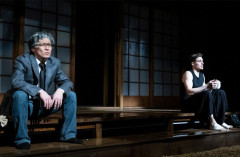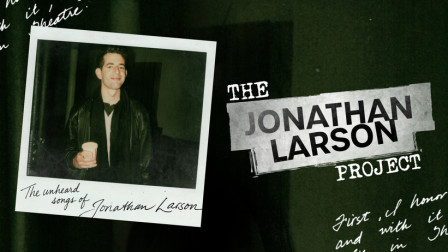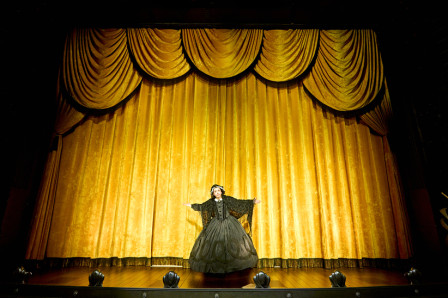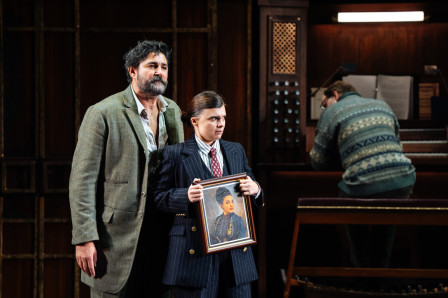Review: THE SEVEN STREAMS OF THE RIVER OTA at Lyttelton Theatre (National Theatre)
 More than 25 years have elapsed since French Canadian auteur Robert Lepage launched his multi-dimensional epic THE SEVEN STREAMS OF THE RIVER OTA on an unsuspecting but largely appreciative Edinburgh audience.
More than 25 years have elapsed since French Canadian auteur Robert Lepage launched his multi-dimensional epic THE SEVEN STREAMS OF THE RIVER OTA on an unsuspecting but largely appreciative Edinburgh audience.
The saga (whose title is derived from the estuary which runs through Hiroshima) starts with a meeting between a Japanese former diplomat’s wife and an American GI tasked with photographing the everyday impact on the nation in the aftermath of the two atomic bomb detonations (which according to conservative estimates, killed 250,000). Emulating the Madam Butterfly plot-line, the two engage in a brief love affair — despite her physical disfigurement as a result of the Hiroshima blast — after which he returns to the US.
The son which results from their union (Jeffrey), leaves behind his blind half-sister and travels to NYC to become a jazz musician and to find his father and half-brother (also Jeffrey). Through various inter-twined plot devices, the small group of friends and extended family then experience life (including a protracted assisted death - a nod to AIDS), over the coming years. The multiple vignettes intersect with scenes set variously in a Nazi death camp (where one of the group, escaped as a child by means of a conjuror’s magic trick), the Expo ‘70 World Fair held in Osaka, and even amidst the backstage scenes of touring troupe’s Feydeau farce.
Back in 1994, this was Lepage’s first full-scale performance piece for his company Ex Machina and it set the stylistic tone in terms of productions composed of scenic tableaux spread over lengthy running times. At 7 hours, ...Seven Streams... may prove challenging to many prospective theatregoers, but the artistry and inventiveness on show, offer considerable rewards to the tenacious and his ardent aficionados will relish every moment.
The simple Japanese sliding screen set is used inventively and provides a multiplicity of imagery to occupy the senses, ably supported by the occasional onstage drumming, opera excepts, comic interplay and atmospheric/technical effects.
Whilst tragedy and destruction are the starting point for the production’s subject matter, ultimately, Hiroshima and the phenomenal resilience of its inhabitants, offer a positive and encouraging nod to the future.
Latest News

 The Jonathan Larson Project announces London premiere
19 December 2025 at 10:31
The Jonathan Larson Project announces London premiere
19 December 2025 at 10:31

 Oh, Mary at Trafalgar Theatre Review
19 December 2025 at 09:46
Oh, Mary at Trafalgar Theatre Review
19 December 2025 at 09:46

 Kerry Ellis completes cast for West End concert of Jo - The Little Women Musical
19 December 2025 at 09:35
Kerry Ellis completes cast for West End concert of Jo - The Little Women Musical
19 December 2025 at 09:35

 Review: TWELFTH NIGHT at the Barbican
18 December 2025 at 19:42
Review: TWELFTH NIGHT at the Barbican
18 December 2025 at 19:42